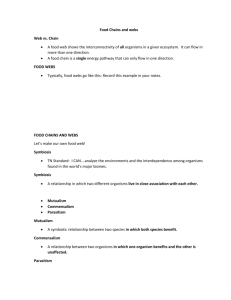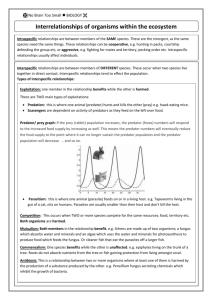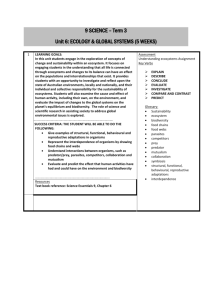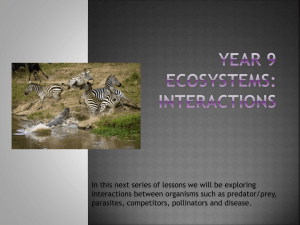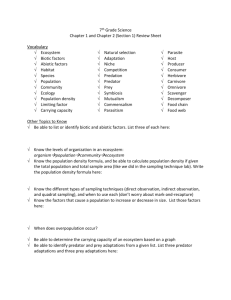10.12B Don`t Eat Me - Texarkana Independent School District
advertisement
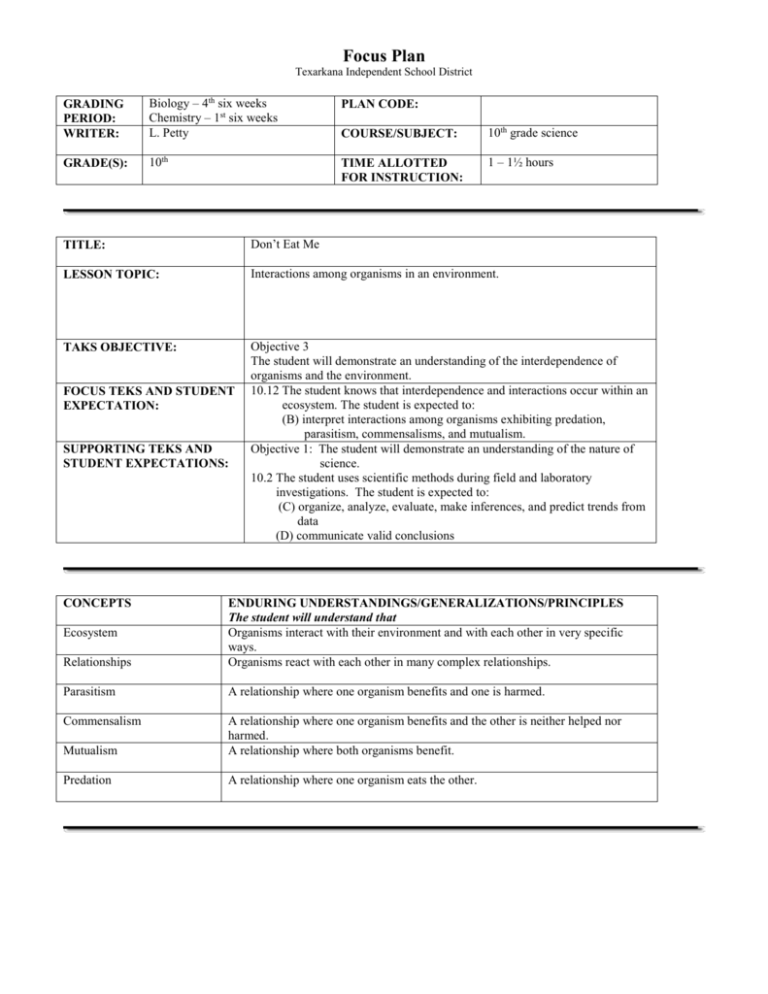
Focus Plan Texarkana Independent School District GRADING PERIOD: WRITER: Biology – 4th six weeks Chemistry – 1st six weeks L. Petty PLAN CODE: COURSE/SUBJECT: 10th grade science GRADE(S): 10th TIME ALLOTTED FOR INSTRUCTION: 1 – 1½ hours TITLE: Don’t Eat Me LESSON TOPIC: Interactions among organisms in an environment. TAKS OBJECTIVE: Objective 3 The student will demonstrate an understanding of the interdependence of organisms and the environment. 10.12 The student knows that interdependence and interactions occur within an ecosystem. The student is expected to: (B) interpret interactions among organisms exhibiting predation, parasitism, commensalisms, and mutualism. Objective 1: The student will demonstrate an understanding of the nature of science. 10.2 The student uses scientific methods during field and laboratory investigations. The student is expected to: (C) organize, analyze, evaluate, make inferences, and predict trends from data (D) communicate valid conclusions FOCUS TEKS AND STUDENT EXPECTATION: SUPPORTING TEKS AND STUDENT EXPECTATIONS: CONCEPTS Relationships ENDURING UNDERSTANDINGS/GENERALIZATIONS/PRINCIPLES The student will understand that Organisms interact with their environment and with each other in very specific ways. Organisms react with each other in many complex relationships. Parasitism A relationship where one organism benefits and one is harmed. Commensalism Mutualism A relationship where one organism benefits and the other is neither helped nor harmed. A relationship where both organisms benefit. Predation A relationship where one organism eats the other. Ecosystem I. SEQUENCE OF ACTIVITIES (INSTRUCTIONAL STRATEGIES) A. Focus/connections/anticipatory set Once students are seated, show a brief clip of a video with a sea anemone and clown fish. B. Instructional activities (demonstrations, lectures, examples, hands-on experiences, role play, active learning experience, art, music, modeling, discussion, reading, listening, viewing, etc.) 1. Lecture Go over vocabulary list. C. Guided activity or strategy Give students the following scenario: a clown fish lives in a sea anemone where it cleans the anemone and prevents certain predators from eating it. What type of relationship is this? Obviously the anemone benefits since it is cleaned and protected. Try to get students to remember the video clip to realize that the sea anemone also catches fish that might be after the clown fish. They should be able to determine that this is a mutualistic relationship. D. Accommodations/modifications Students requiring accommodations may be given a completed copy of the vocabulary. E. Enrichment Students requiring enrichment may be assigned the vocabulary prior to the activity. II. STUDENT PERFORMANCE A. Description Complete Activity – Don’t Eat Me B. Accommodations/modifications Students requiring accommodations should be assigned a peer tutor. C. Enrichment Students requiring enrichments should be peer tutors. III. ASSESSMENT OF ACTIVITIES A. Description Grade Activity Worksheet – Don’t Eat Me. B. Rubrics/grading criteria Each answer in the data table should be graded at 3 points each. Incorrectly answered answers or boxes left blank should have these points deducted. C. Accommodations/modifications Since students may work with peer tutors, no accommodations should be needed. D. Enrichment Students may be given an assignment to provide an additional example for each type of symbiotic relationship. E. Sample discussion questions 1. 2. 3. 4. 5. IV. What type of relationship has one organism benefiting and one being harmed? Parasitism What type of relationship has both organisms benefiting? Mutualism What type of relationship has one organism benefiting and one being neither harmed nor helped? Commensalisms What type of relationship has one organism killing and eating the other? Predation What is the difference between parasitism and predation since both have one organism benefiting and one being harmed? In parasitism, the parasite usually does not want to kill the host since this would kill the parasite also. TAKS PREPARATION A. Transition to TAKS context 1. Many different types of interaction take place between organisms in an ecosystem. Which of the following statements provides the best description of a predator-prey relationship within an ecosystem? (a) The predator feeds on the prey. The predator is helped and the prey is harmed. (b) The prey feeds on the predator. The prey is helped and the predator is harmed. (c) The predator feeds on the prey. The predator is harmed and the prey is helped. (d) The prey feeds on the predator. The prey is harmed and the predator is helped. 2. Certain fungi and green algae live together as lichens in some ecosystem niches. The algae provide food for the fungi, and the fungi provide water conservation and protection for the algae. What term describes this interaction that benefits both organisms? (a) amensalism (b) mutualism (c) parasitism (d) commensalisms 3. There are numerous interactions between organisms in freshwater lake ecosystems. What interactions should be notices by a careful observer? (a) Aquatic plants and snails compete for sunlight while fish and birds compete for snails. (b) Aquatic plants and snails have a symbiotic relationship while fish and birds have a predator-prey relationship. (c) Aquatic plants are eaten by snails, snails are prey for fish, and fish are prey for birds. (d) Aquatic plants and snails have a parasitic relationship while fish and birds have a symbiotic relationship. B. Sample TAKS questions Spring 2004 1. An oakworm caterpillar feeds on the leaves of an oak tree. This type of interaction is _____. (a) mutualistic (b) commensalistic (c) competitive (d) parasitic 2. After being introduced in the 1930s, the fire ant (Solenopsis invicta) became established throughout much of the southern United States. One biological way to control fire ants might be to introduce organisms that are ____. (a) mutualistic with fire ant queens (b) nurtured by fire ant workers (c) preyed on by fire ant drones (d) parasitic to fire ant larvae 3. A hummingbird feeds on the nectar of a flowering plant. In this process the bird gains nutrition while spreading the plant’s pollen to other flowers. The relationship between hummingbirds and flowering plants can be described as ____. (a) commensal (b) predatory (c) parasitic (d) mutualistic V. KEY VOCABULARY commensalisms competition host mutualism parasite VI. parasitism predation predator prey symbiosis RESOURCES A. Textbook None needed B. Supplementary materials/equipment Transparency master – Vocabulary Instructor’s Copy – Vocabulary Activity Worksheet – Don’t Eat Me Instructor’s Copy – Don’t Eat Me C. VII. Technology FOLLOW UP ACTIVITIES (reteaching, cross-curricular support, technology activities, next lesson in sequence, etc.) A. Reteaching Go over graded worksheet. B. Next lesson in sequence Biology – 12C – compare variations, tolerances, and adaptations of plants and animals in different biomes Chemistry – 12E – investigate and explain the interactions in an ecosystem including food chains, food webs, and food pyramids VIII. TEACHER NOTES Before activity: 1. Make transparency master of vocabulary 2. Run off worksheets so that every student has one.

